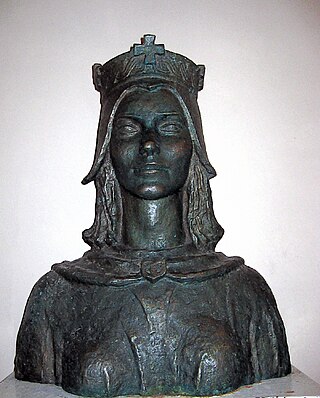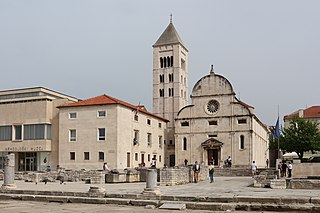
The Madi family (Croatian : Madijevci) was a patrician family from Zadar. They were influential in Croatian politics from the 10th to 12th centuries. [1]

The Madi family (Croatian : Madijevci) was a patrician family from Zadar. They were influential in Croatian politics from the 10th to 12th centuries. [1]

Dalmatia is one of the four historical regions of Croatia, alongside Central Croatia, Slavonia and Istria, located on the east shore of the Adriatic Sea in Croatia.

Zadar, historically known as Zara, is the oldest continuously inhabited city in Croatia. It is situated on the Adriatic Sea, at the northwestern part of Ravni Kotari region. Zadar serves as the seat of Zadar County and of the wider northern Dalmatian region. The city proper covers 25 km2 (9.7 sq mi) with a population of 75,082 in 2011, making it the second-largest city of the region of Dalmatia and the fifth-largest city in the country.

Silba is an island in Croatia with an area of 15 km2, northern Dalmatia, south-east of Lošinj, between the islands of Premuda and Olib. It has a Mediterranean climate with 2570 hours a year of sunshine. Most summer days are hot, bright and clear with light westerly maestral wind cooling the island in the afternoons.

Biograd na Moru, shortened to simply Biograd, is a town in northern Dalmatia, Croatia and is significant for being another capital of the medieval Kingdom of Croatia. Biograd is administratively part of the Zadar County. It is located on the Adriatic Sea coast, overlooking the island of Pašman, on the road from Zadar and Sukošan towards Vodice and Šibenik.

Peter Krešimir IV, called the Great was King of Dalmatia and Croatia from 1059 until his death in 1074 or 1075. He was the last great ruler of the Krešimirović branch of the Trpimirović dynasty.
The History of Dalmatia concerns the history of the area that covers eastern coast of the Adriatic Sea and its inland regions, from the 2nd century BC up to the present day.
Paul I Šubić of Bribir was Ban of Croatia between 1275 and 1312, and Lord of Bosnia from 1299 to 1312. As the oldest son of Stephen II of the Šubić noble family, he inherited the title of count of Bribir. He was appointed ban in 1273. He was relieved from duty in 1274, following his involvement in disputes between the Dalmatian coastal cities of Trogir and Split, and was returned to office in 1275.
Stephen I was King of Croatia from c. 1030 until his death in 1058 and a member of the Trpimirović dynasty. Stephen I was the first Croatian king whose given name was "Stephen" ("Stjepan"), as Držislav added the name Stephen at his coronation. His ban was Stephen Praska.
Stephen II was the last member of the Trpimirović dynasty and last native king of Croatia to rule the entire medieval Croatian Kingdom. Stephen's father was Gojslav II, the younger brother of Peter Krešimir IV of Croatia. Stephen was duke of Croatia under Krešimir around 1066.

Helen of Zadar, also known as Helen the Glorious, was the queen consort of the Kingdom of Croatia, as the wife of King Michael Krešimir II, from 946 to 969, a period which was marked by "peace, order and expeditious growth". She was the regent of Croatia after the death of her spouse during the minority of her son Stephen Držislav of Croatia, and ruled from 969 until 976.

The Monastery of St. Francis Assisi in Zadar is a Roman Catholic Franciscan monastery dating back to the 13th century. The monastery is held by the Franciscan Province of Saint Jerome.

Kruno Prijatelj (1922–1998), was a Croatian art historian, art critic and University professor.

The Theme of Dalmatia was a Byzantine theme on the eastern coast of the Adriatic Sea in Southeastern Europe, headquartered at Jadera.
Vekenega was a Croatian Benedictine nun from the House of Madi, a noble family from Zadar. She was the daughter of Čika and the abbess of the Benedictine monastery of St. Maria in Zadar from 1072. She is also known for the richly illuminated evangelistary, which she commissioned in the scriptorium of the monastery of st.Krševan in 1096.
Godemir or Godimir was Ban of Croatia during 10th century Croatia. He is said to have served the king Stephen Držislav in a charter from 1068. According to the much debated Chronicle of Archdeacon Goricensis John, he was established to his position by a certain King Krešimir. He is also referred to in a charter as potens banus, meaning "powerful ban".

Dalmatian city-states were the Dalmatian localities where the local Romance population survived the Barbarian invasions after the fall of the Western Roman Empire in the 400s CE. Eight little cities were created by those autochthonous inhabitants that maintained political links with the Eastern Roman Empire. The original names of these cities were Jadera, Spalatum, Crespa, Arba, Tragurium, Vecla, Ragusium, and Cattarum. The language and the laws were initially Latin, but after a few centuries, they developed their own Neo-Latin language, Dalmatian, which lasted until the 19th century. The cities were maritime centres with huge commerce, mainly with the Italian peninsula and with the growing Republic of Venice.

The Kačić family was one of the most influential Croatian noble families, and was one of the Croatian "twelve noble tribes" described in the Pacta conventa and Supetar Cartulary. Historical sources refer to members of this family as nobles in the area of the Luka županija in the Zadar-Biograd hinterland, as the lords (knezes) of Omiš, and as the lords of the Makarska Riviera. Another prominent branch of the family, Kacsics, was part of the Hungarian nobility and from it branched many families including Szécsényi.

Čika was a Croatian benedictine nun, founder of the benedictine monastery of St. Mary Church in Zadar. She is also known for the illuminated prayer book known as Čika's book of hours, the oldest prayer book for personal use in Europe.

Church of St. Mary is a Benedictine monastery located in Zadar, Croatia. It was founded in 1066 on the eastern side of the town's old Roman forum.

The Gusić family, also known as Gušić, was one of the twelve noble tribes of the Kingdom of Croatia, mentioned in the Pacta conventa. They originated from the hinterland of Biograd in the medieval Luka and Sidraga županijas, where they are recorded at least since the 11th century. Their main regions of influence were Krbava and Gacka, where they often served as župans and knezes at least since the early 13th century. In the 14th century branched Posedarski who seated in Posedarje, and Kurjakovići who as magnates managed to gather much wealth and have high official positions at the Hungarian royal court as well two of their members became Ban of Croatia. As experienced warriors, they actively participated in the Croatian–Ottoman and late Ottoman–Venetian Wars. Direct descendants of the tribe with the surname Gusić, and possibly Gušić, live even today in Croatia and Slovenia.